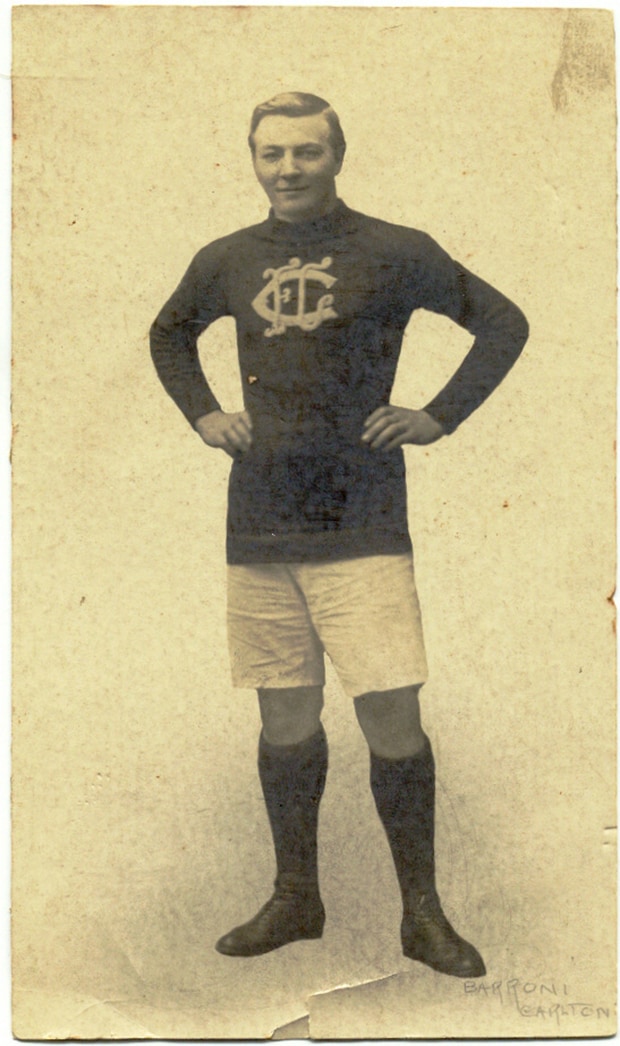Sergeant George David Challis
58th Infantry Battalion
Died Armentieres, France, July 15, 1916, aged 25 years
70 games for Carlton, 1912-1915
The Tasmanian-born George Challis was a feted member of the old dark Navy Blues’ 1915 premiership team. Recently, almost 100 years after his tragic demise, George was one of ten young men remembered with affection by the respected Melbourne author Ross McMullin, in his recently-released 600-page multi-biography “Farewell, Dear People: Biographies of Australia’s Lost Generation”.
The following is Ross’s assessment of George the man.
George was intelligent, widely admired and very popular. It wasn’t just that he was a brilliant player with dazzling skill and pace, and (unusual for the times) superb disposal — it was also the way he played the game. It was said that George always had a smile on his face. He was keen, he wanted to succeed and he wanted to win, but the crowd could tell George enjoyed what he was doing. He was known as ‘Cheerful Challis’ and ‘Genial George’.
Outside footy, George was very able scholastically. He won a scholarship that took him from the tiny Tasmanian hamlet of Cleveland, where he was born and raised, to Launceston where he went to secondary school. So impressed was the school’s headmaster with George’s academic prowess that he took George on as a teacher, and George was teaching at the time he made for the mainland across Bass Strait en route to Princes Park.
In Melbourne George took up work as an audit clerk with the Railways. As an example of the wide-ranging interests he developed, he also became an enthusiast of the Esperanto Society. This international language was probably not something your average VFL player was into, but it was reported in the papers of the day that he was an activist with the society in Melbourne.
George was recruited to Carlton after the 1911 interstate carnival, when he represented Tasmania and won a medal for his state’s best player. The Carlton talent scouts clearly liked what they saw.
The VFL was a big step up, and George started slowly at Carlton in 1912. But he gradually got into his stride, and became a brilliant performer in a succession of games for his new club — the high point being when the team met Essendon on the 13th of July of that year.
Here’s what the Essendon coach Jack Worrall (the former Carlton premiership coach), wrote about George’s play that day:
“Challis was the best performer on the ground, excelling in every department, the ease and grace of his movements exciting universal admiration. He was the fastest man on the ground, and his beautiful, accurate passing while going at his top was marvellous.”
Injury unfortunately cost George a place in Carlton’s 1914 premiership team, but he overcame that setback and, wearing the No.12 now worn by Blaine Boekhorst, was considered amongst his team’s best players afield in the 1915 Grand Final victory.
At the end of the 1914 season, after the outbreak of hostilities in Europe, George tried to enlist with his Carlton teammate and close friend Stan McKenzie. But there was an unexpected stumbling block in that while Stan got a tick and went off to war, George was adjudged to be medically unfit because he had one toe slightly overlapping another.
But George kept trying and in the end was accepted. That happened in July 1915 after the Gallipoli landing, when word filtered back of the substantial casualties and the authorities stopped fussing about technicalities.

George Challis was a feted member of Carlton's 1915 premiership team.
George was made a sergeant soon after enlisting. In recognition of his leadership qualities, he was told that officer training was open to him to become a lieutenant. George said no, I’ve enlisted to fill gaps and the sooner we get over there the better, so he declined that offer and remained a sergeant.
After George arrived in Egypt he became part of the newly established 58th Battalion. This unit was part of the 15th Brigade commanded by the famous Brigadier-General Harold “Pompey” Elliott, who I’ve previously written about.
It was on July 15, 1916, not long after his unit entered the forward trenches in France, that George Challis was killed.
His death occurred in the lead-up to the notorious battle of Fromelles, the worst 24 hours in Australian history, when there were 5533 Australian casualties in one night. That battle actually started on the 19th, but four days earlier the Germans launched a major raid supported by a severe bombardment, which caused 160 casualties in the 58th Battalion . . . amongst them George, who was blown to bits by a direct hit.
George was very much a battalion favourite — so much so that his many admirers decided to gather what was left of him to get him properly buried . . . and they collected his remains in a blanket. He was buried nearby, in the cemetery at Rue Petillon.
News of the death of an officer standing next to George was reported in Australia some weeks before George’s own death was confirmed. Remarkably, the news of the death of the man who’d excelled for Carlton in the 1915 Grand Final surfaced just a few days before the 1916 Grand Final -— and is why the Carlton players ran out wearing black armbands in acknowledging their mate who’d dominated the play in the preceding year with them.
The news of George’s fate caused widespread sadness in both Launceston and Melbourne, together with his birthplace in Cleveland where his family still lived. As the Adelaide Advertiser reported, “Expressions of regret were heard yesterday all over Melbourne when it became known that George Challis had fallen in France”.
George’s parents Charlie and Margaret were invited to choose an inscription for their boy’s grave. In response, they provided the following epitaph: “Tho’ death divides, fond memory clings”.
Charlie and Margaret never visited George’s final resting place, but their son’s epitaph remained forever in their thoughts after the government supplied them with graveside photographs.
A memorial stone for George was also erected in Cleveland cemetery, and at the little nearby church there’s a memorial to him. If you peer through the window you can see his name there, at the top of the Honour Roll for Cleveland’s war dead.
But remembrance of George Challis extended beyond headstones and honour boards. He was fondly recalled extraordinarily often by nostalgic Tasmanians and frustrated Carltonians who lamented his absence as they ruefully looked back to the good old days.
Joe Lyons, who was to become Prime Minister of Australia, knew the Challis family well in his early days as a teacher, and he used to watch George play for Launceston whenever he could.
Years later, on an emotional pilgrimage to Fromelles as Prime Minister, Joe paid his respects at George’s grave.
George Challis was 25 years old when he died — the same age as Matthew Kreuzer is now. It’s very sad that individuals of such calibre as George were lost and were denied the opportunity to lead full and fulfilling lives, which would have enriched the nation immensely.
But it’s worse still if we forget them.



